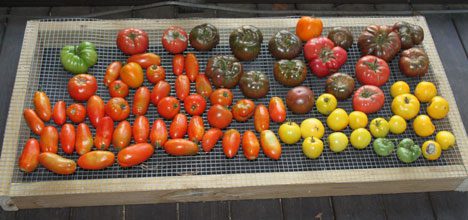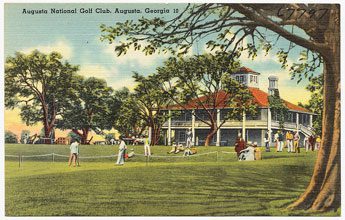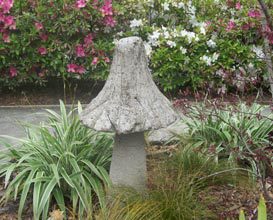 Ah, tomatoes. The delight and the bane of home gardeners everywhere. Especially here. Down here in the Lowcountry, our soil is full of fungi, wilts and blights that decimate our ‘Brandywine’, ‘German Johnson’, ‘Mortgage Lifter’ and most other heirloom tomatoes.
Ah, tomatoes. The delight and the bane of home gardeners everywhere. Especially here. Down here in the Lowcountry, our soil is full of fungi, wilts and blights that decimate our ‘Brandywine’, ‘German Johnson’, ‘Mortgage Lifter’ and most other heirloom tomatoes.
Only the new hybrids, which are specifically bred to be disease, fungus and wilt resistant are really successfully grown in-ground down here. The letters you find after these hybrids’ name mean that they are resistant to the following:
- V: A tomato variety with this letter listed after the name is resistant or tolerant to verticillium wilt, a disease caused by a fungus that lives in cool moist soil and works its way into the plants vascular system through its roots, clogging the water conducting tissue in the plant, which prevents water from reaching the stems and leaves.
- F: Fusarium wilt has similar symptoms to verticillium wilt, but is a different fungus. Plants will begin to wilt, drop leaves, and begin to get chlorotic, meaning the leaves begin yellowing.
- N: Nematode resistance refers to organisms living in the soil. Nematodes can be beneficial as well as a pest such as the one that attacks the roots of tomatoes, called root-knot nematode. The N denotes a resistance to this nematode.
- T: Resistance to tobacco mosaic virus. Tomatoes and tobacco are in the same family, Solanacea, and are susceptible to a virus that causes the leaves to become mottled and discolored, creating a mosaic-like pattern that gives the disease, tomato mosaic virus, its name.
- A: Alternaria is a mold that thrives on certain vegetation including tomatoes. It usually shows up as small black spots on the bottom of the fruit.
But these new hybrids just don’t have the heirloom taste we all yearn for. So today, commercial growers have begun to offer heirloom tomato plants grafted onto resistant hybrid tomato rootstock. Grafted plants are more expensive, but you get the wonderful taste we remember from a plant that is resistant to attack by those diseases and viruses. Even so, most home gardeners down here have better success with planting their tomatoes in containers or raised beds using fresh potting soil each year.
Tomato plants are classed as Determinate or Indeterminate. Determinate plants are smaller, usually about 3 feet tall, and the fruit ripens all at once early in the season. Indeterminate plants can become quite large and continue fruiting until killed by frost.
The Guinness Record for the tallest tomato plant is 65 feet, and the record for the most tomatoes harvested in one year from a single plant is held by Epcot’s Land Pavilion with over 32,000golf ball size tomatoes. This tomato tree was grown from seeds from China, and is treated as a greenhouse perennial, taking two to three years to yield fruit. Epcot’s is 12 feet tall and over 20 feet wide. The harvest is served at the restaurants at Disney World, and if you’re served one, save the seeds! It might not be a hybrid and would come “true” from seeds.
During the heat of the summer, tomato plants will stop flowering and producing. But they’re not through, so don’t pull up those plants and toss them. Just cut them back to about 12 inches and fertilize. Their established root systems will provide better access to nourishment than new seedlings or cuttings planted for your fall crop. In fact, I have two tomato plants (indeterminate) from last springwhich are still producing even as this is published. They were somewhat protected on my front porch, but other than their summer haircut, no special care or protection was taken. They never actually stopped producing, and I had fresh tomatoes for my Christmas table. There are several nice sized fruits slowly ripening in this cool weather, and they’re full of flowers for a third crop! Concentrate your regular fertilizing to when flowering has begun; heavy fertilizing early in the season will result in lots of foliage and no flowers.
Remember, neverstore tomatoes in the refrigerator. If you absolutely must have your tomatoes cold, wait for them to ripen fully, then chill them for a few hours before serving. This short chilling won’t noticeably change the flavor of a fully ripened tomato.
True, keeping tomatoes refrigerated slows down the ripening process and prevents them from rotting, but it also interferes with the volatiles; the chemical compounds which give tomatoes their rich flavor. That’s one of the reasons why store-bought tomatoes have so little taste – even those that are labeled ‘heirloom.’ Commercially sold tomatoes are picked before fully ripe and kept cold until they’re actually in the stores.
Tomatoes canbe successfully ripened off the vine without significant loss of flavor, but not if they have been chilled for more than a few hours. However, the flavor of even pre-chilled tomatoes can be improved somewhat with a three or four day room-temperature recovery period. Just remember that tomatoes should be stored stem side down and out of direct sunlight. There is less chance of moisture leaving and air coming in if the cut stem isn’t exposed. Some sites suggested that you put a piece of tape over the cut stem, but that seems a little too obsessive, doesn’t it?
We joke about the $10.00 tomato. You know the one where we bought a special tomato container or raised bed, a cage for it to climb on, and all kinds of unique fertilizers and soil additives and mollycoddled it until it had flowers and ultimately got only one or two lonely tomatoes.
Every year, I say that I am going to leave growing tomatoes to the folks at the Farmers’ Market. Then I see that they, too, have elevated perceptions of the worth of their heirlooms. OK, so they’re not $10 tomatoes; they’re only $4.00 tomatoes!
I pay it reluctantly and seldom, but still I pay it because they have done all the work and all I have to do is take it home.
That being said, each year I succumb to the pictures of succulent, ripe tomatoes in the seed catalogs, and try again. I’m inordinately proud of the tomatoes all this effort produces, but then I’m a gardener and we’re entitled to be forgiven such harmless vanity. Aren’t we?
And don’t forget the Flower Show at Tabby Place in downtown Beaufort on Thursday, May 16th. It’s free and open from 9 until 5. The Beaufort Council of Garden Clubs is sponsoring this gift to the people of Beaufort. You’ll get to see prime exhibits of what can be grown down here, along with exotics and some creative and imaginative designs in the Botanical Arts Division. See you there!







